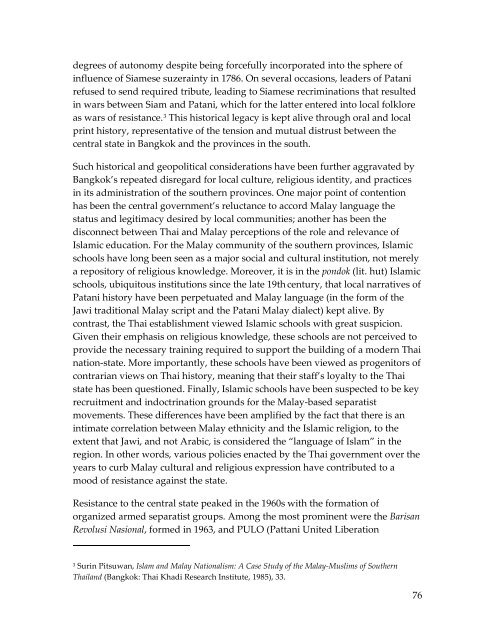Create successful ePaper yourself
Turn your PDF publications into a flip-book with our unique Google optimized e-Paper software.
degrees of autonomy despite being forcefully incorporated into the sphere of<br />
influence of Siamese suzerainty in 1786. On several occasions, leaders of Patani<br />
refused to send required tribute, leading to Siamese recriminations that resulted<br />
in wars between Siam and Patani, which for the latter entered into local folklore<br />
as wars of resistance. 3 This historical legacy is kept alive through oral and local<br />
print history, representative of the tension and mutual distrust between the<br />
central state in Bangkok and the provinces in the south.<br />
Such historical and geopolitical considerations have been further aggravated by<br />
Bangkok’s repeated disregard for local culture, religious identity, and practices<br />
in its administration of the southern provinces. One major point of contention<br />
has been the central government’s reluctance to accord Malay language the<br />
status and legitimacy desired by local communities; another has been the<br />
disconnect between Thai and Malay perceptions of the role and relevance of<br />
Islamic education. For the Malay community of the southern provinces, Islamic<br />
schools have long been seen as a major social and cultural institution, not merely<br />
a repository of religious knowledge. Moreover, it is in the pondok (lit. hut) Islamic<br />
schools, ubiquitous institutions since the late 19th century, that local narratives of<br />
Patani history have been perpetuated and Malay language (in the form of the<br />
Jawi traditional Malay script and the Patani Malay dialect) kept alive. By<br />
contrast, the Thai establishment viewed Islamic schools with great suspicion.<br />
Given their emphasis on religious knowledge, these schools are not perceived to<br />
provide the necessary training required to support the building of a modern Thai<br />
nation-state. More importantly, these schools have been viewed as progenitors of<br />
contrarian views on Thai history, meaning that their staff’s loyalty to the Thai<br />
state has been questioned. Finally, Islamic schools have been suspected to be key<br />
recruitment and indoctrination grounds for the Malay-based separatist<br />
movements. These differences have been amplified by the fact that there is an<br />
intimate correlation between Malay ethnicity and the Islamic religion, to the<br />
extent that Jawi, and not Arabic, is considered the “language of Islam” in the<br />
region. In other words, various policies enacted by the Thai government over the<br />
years to curb Malay cultural and religious expression have contributed to a<br />
mood of resistance against the state.<br />
Resistance to the central state peaked in the 1960s with the formation of<br />
organized armed separatist groups. Among the most prominent were the Barisan<br />
Revolusi Nasional, formed in 1963, and PULO (Pattani United Liberation<br />
3<br />
Surin Pitsuwan, Islam and Malay Nationalism: A Case Study of the Malay-Muslims of Southern<br />
Thailand (Bangkok: Thai Khadi Research Institute, 1985), 33.<br />
76


